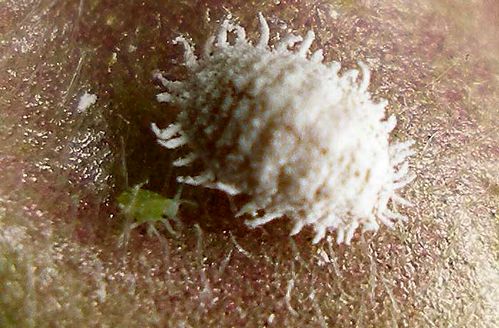Insects that damage the African violet: Woolly louse (Pseudococcidae)
 Woolly louse (Pseudococcidae) it is without a doubt a unique representative of the world of insects. Each species of louse differs from the others by the structures of the waxy sediments that cover their bodies. But, this variety of forms does not delight the eye of any lover of exotic plants.
Woolly louse (Pseudococcidae) it is without a doubt a unique representative of the world of insects. Each species of louse differs from the others by the structures of the waxy sediments that cover their bodies. But, this variety of forms does not delight the eye of any lover of exotic plants.
Woolly lice - is the most widespread and numerous group of insects. Many representatives of this group are aggressive pests for plants in rooms and from the environment.
Woolly lice are characterized by sexual dimorphism, females are very different from males.
The body of males, it resembles that of many insects. They have the head, Chest, well-defined abdomen, and their wings are well developed.
The body of females is round or slightly elongated, it is not sectioned, resembling rather to that of the larvae.
Mature males no longer feed and their life expectancy is quite short.
Females are quite fertile, and the waxy sediment on the surface of the body protects them from the insecticides with which the plant is treated, making the fight against them even more difficult.
This pest has the ability to become in a relatively short time immune to many insecticides with which the attacked plant is treated.
The most widespread species that attack indoor plants are : woolly seaside lice (Pseudococcus maritimus), beautiful lice (P. adonidum), citrus woolly lice (Planococcus citri) and that of the vine (P. calceolariae).
Those who are regularly found on parma violets, especially those grown in greenhouse conditions, are the woolly seaside lice and the fainous.
Woolly seaside lice (Pseudococcus maritimus): The body of the adult female is pink in color, covered with a whitish sediment of waxy consistency. Along the body are distributed 17 pairs of elongated and thin waxy spikes. The last pair is the longest, but the length of the spikes does not exceed half the length of the female's body.
The dimensions of the female are usually 5 x 3 mm. Adult lice and larvae colonize the axillary points of the leaf, the dimples formed in the places where the ribs of the leaves branch on the lower part of the leaf.
The females of the species in question are quite fertile. Only one female can lay 300-400 eggs once. In apartment or greenhouse conditions, the female of the woolly coastal lice gives birth to 5 generations per year.
Until the appearance of better performing insecticides, the appearance of these pests in the collection of many amateurs of violets was equivalent to a death sentence of many plants. The plants were washed for months with a solution made of soap + medicinal spirits or soap + petroleum, that did not work, giving only a temporary respite to the plant.
 Beautiful lice (P. adonidum) has a much more consistent waxy sediment than in the first species. The last pair of abdominal spikes is longer than the others, exceeding the length of the body. Moving on the host plant, the female is looking for more secluded places where she weaves a net where she lays eggs in groups.
Beautiful lice (P. adonidum) has a much more consistent waxy sediment than in the first species. The last pair of abdominal spikes is longer than the others, exceeding the length of the body. Moving on the host plant, the female is looking for more secluded places where she weaves a net where she lays eggs in groups.
In the species in question, the eggs hatch quite quickly. The fernity of a single female varies within the limits of 50-250 eggs.
The presence of woolly lice is signaled by the white fluff on the plant and the sticky secretion known as "honey dew".
Woolly lice are polyphytophagous species. They sting the plant and suck the cellular juice. The plant loses nutrients, and the feeding lice secrete saliva into the plant tissues that contain digestive enzymes that negatively affect the plant's metabolism.
In case of a massive attack, the plant loses its decorativeness, prickly tissues deform, leaves and flower buds die. The plant becomes sensitive to secondary infections and with time dies.
Woolly lice fight with insecticides like: Actara, Mospilan, Dantop, Sinotorax, Actelic 50 EC-0,05%, Fastac 10 EC-0,02%, Mavrik 2F-0,05%, Sanvalerate 20 EC -0,04%, Zolone 35 EC–0,2%, Ekalux 50 EC-0,1%, Sumi-Alpha 2,5 EC–0,04%, Sumicidin 20 EC-0,04%, Nomolt 15 EC–0,05%, Decis 25 WG-0,05%; Lannate 25 WP-3 kg/ha; Magic 20 CE-0,3%; Magic Super 20 CE-0,2%, Pallas-0,3%; Pyrinex 20 EC-0,3%.
It is also recommended to use a penetrating like Silwet L that is added to the solution with which we water the plant.
It is desirable to make at least two chemical treatments at an interval of 10 days.
There are also woolly lice immune to treatment with Actara, in this case another insecticide will be used.
Insecticides like Fitoverm, Actophyte, Acarin does not give the ateptat result in combating the woolly lice. These insecticides can be included in the component of systemic insecticides, significantly improving their effect on this pest.

